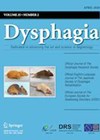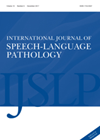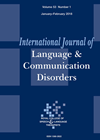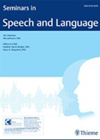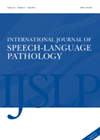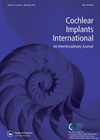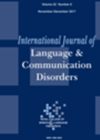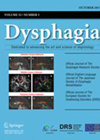
Journal Reviews
Telepractice for the delivery of paediatric feeding services
During the current COVID-19 pandemic, telepractice is being heralded as the safest service delivery mode for the majority of outpatient consultations. Patients are reviewed by their healthcare specialist through video consultations, thus avoiding the need for patients to leave their...
What do SLTs do in palliative care?
The authors of this article highlight that the number of older people has increased significantly in the last two decades, and the number of people over 85 has doubled in Australia since 1996. They attribute this to improved lifestyle factors...
What the people want and need: emerging service for communication needs in Ghana
There is a significant shortfall in rehabilitation service for people with communication difficulties across Majority World countries. It is known that many people in these countries are likely to seek help from a variety of sectors including western healthcare, religious...
Doing it for the men: diversifying the speech and language therapy profession
It is known that many health professions are dominated by females, particularly the allied health professions, such as speech and language therapy. This is more pronounced in the US than in the UK, Australia and other countries. The authors of...
Humour to improve clinician - patient interactions
This study examined the role of humour employed by the speech language graduate student during their one-on-one therapy sessions with people with aphasia (PWA). The students used humour to soften the errors made by the clients; to equalise interactional power;...
Do it like a techy: telepractice in SLT for people with Parkinson’s disease
Parkinson’s disease (PD) is the second most common neurological condition in Australia, and communication difficulties are reported by 90% of people with the condition. Unfortunately, not all people with PD have access to speech and language therapy services due to...
Socially appropriate part II: therapy for people with TBI
Social communication is a complex behaviour comprising social and cognitive communication skills. Providing speech and language therapy (SLT) interventions for people with social communication difficulties following traumatic brain injury (TBI) requires the clinician to understand how ingredients from an evidence-based...
The paediatric dilemma of one ear in and one ear out of NICE criteria
The auditory implant team in Manchester have implanted a cohort of children where audiological thresholds meet the NICE guidance for cochlear implantation (CI) in one ear only, and the other falls into moderate, severe or sloping loss. These children are...
Help or hinder: how and why do SLTs make clinical decisions around swallowing?
Dysphagia is a relatively common consequence of stroke, with estimates between 50% and 60% of people presenting with swallowing dysfunction following stroke. It is associated with pneumonia, malnutrition and dehydration which in turn lead to increased length of hospital admission,...
Multilingualism in a monolingual environment: shifting perspective for economic benefits
English proficiency amongst migrant populations has a relatively high profile in the UK education system at present. This article compared data from two Australian national censuses with the aim of describing the English proficiency of the Australian population, to explain...
Developmental language disorder
Disorders such as attention deficit disorder (ADHD), autism spectrum disorder and developmental dyslexia have received widespread recognition. As a result, children affected by these conditions are able to receive remedial services. In this article, the author discusses the possible reasons...
Should patients with dysphagia be allowed water freely?
Patients with dysphagia often experience dehydration as a consequence of “nil by mouth” or having to consume thickened fluids due to aspiration of thin fluids. However, not all incidents of aspiration develop into an infection. Factors that contribute to aspiration...

